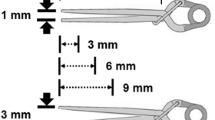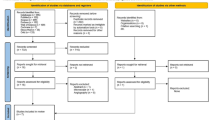Abstract
Although closing force of cobalt alloy clip is well studied, there is only little information of titanium alloy clip available in the literature. In the present study, we examined and compared closing forces of various types and points of cerebral titanium and cobalt aneurysm clips for cerebral aneurysms. Straight, temporary, bayonet, angled, and fenestrated titanium or cobalt alloy clips were tested by measuring the closing forces at various points along their blade length. Closing forces of all the tested clips linearly increased from tip to base of clip blades. Sugita Titanium II clips had bigger closing forces than Elgiloy clips in all type clips except for the temporary clips. The closing forces of Sugita Titanium II and Yasargil titanium clips were similar in straight permanent type clip although there were some differences in closing forces between other types of Sugita and Yasargil clips. Our data showed that the closing forces differed depending not only on manufacturers but also on materials and shapes.





Similar content being viewed by others
References
Dujovny M, Kossovsky N, Kossowsky R, Perlin A, Segal R, Diaz FG, Ausman JI (1984) Intracranial clips: an examination of the devices used for aneurysm surgery. Neurosurgery 14:257–267
EN ISO 9713:2009 Neurosurgical implants—self-closing intracranial aneurysm clips (ISO 9713:2002)
Horiuchi T, Hongo K, Shibuya M (2012) Scissoring of cerebral aneurysm clips: mechanical endurance of clip twisting. Neurosurg Rev 35(2):219–224
Nagatani T, Shibuya M, Ooka K, Suzuki Y, Takayasu M, Yoshida J (1998) Titanium aneurysm clips: mechanical characteristics and clinical trial. Neurol Med Chir (Tokyo) 38(Suppl):39–44
Ooka K, Shibuya M, Suzuki Y (1997) A comparative study of intracranial aneurysm clips: closing and opening forces and physical endurance. Neurosurgery 40:318–323
Sugita K, Hirota T, Iguchi I, Mizutani T (1976) Comparative study of the pressure of various aneurysm clips. J Neurosurg 44:723–727
Disclosure
No financial support was provided in the present study. Mizuho Co., Ltd donated Sugita clips and lent the forcemeter, however, the company did not have any role in data analysis, interpretation, or in writing of this manuscript. The authors have no perceived conflicts of interest.
Author information
Authors and Affiliations
Corresponding author
Additional information
Comments
Taketo Hatano, Kyoto, Japan
This is an interesting manuscript that addressed our clinical question. The authors investigated closing forces of various types and points of titanium and cobalt clips for cerebral aneurysms. Sugita Titanium II clips had bigger closing forces than Elgiloy clips. There were some differences in closing forces between various shapes of clips. In addition, Sugita Titanium II clips have similar or better opening width of blades.
This article provides additional accurate information on the clips for cerebral aneurysm. It is important to gain intimate acquaintance with the surgical instruments for performing a safe surgery.
Nobutaka Kawahara, Yokohama, Japan
In this manuscript, the authors have described the mechanical properties of recently introduced Sugita Titanium II clips. According to their data, closing forces of Sugita Titanium II clips are generally higher than previous cobalt Elgiloy clips. This closing force increases as it approaches proximally but their increments are larger in straight clips than in angled clips. These results would provide objective data for neurosurgeons when selecting various types of clip for complex aneurysms.
Though titanium clips were introduced to increase safety and visualization of various imaging modalities, particularly in MRI imaging, the most disadvantages were the weakness (low closing force) and metal fatigue (decrease of closing force after repetitive opening), which most neurosurgeons consider inadequate for use in larger complex aneurysm. We also experienced residual flow after single clip application even for moderate-sized aneurysm, so that we should sometimes confirm complete obliteration after double clipping. However, the second-generation titanium clips, such as Sugita Titanium clips described here, are generally stronger (higher closing forces) than the first generation, even better than previous Elgiloy clips. The data provided here reconfirmed the data advocated by the manufacturer and assure the safety of titanium clips for use in large complex aneurysm. As the authors stated, however, these closing forces are somewhat weaker in angled clips as expected, we should also be cautious when applying these clips. Multiple clip technique would be required in these cases. Comparison with the Yacargil’s titanium clips is not adequate in this manuscript, since the number of trials is not sufficient to make comparison reliable. Though what kind of titanium clips is used would still depend on neurosurgeons preference, we should know these basic mechanical properties when selecting different types clips to ensure the safety of the treatment.
Louis J. Kim, Seattle, USA
Horiuchi et al. present benchtop analysis of torque forces necessary to produce aneurysm clip scissoring. This included variations in clip shapes, clipping depth, manufacturer, and materials. Not surprisingly, shorter clipping depths required less torque to scissor clips due to the increased fulcrum distance than longer clip depths. Differences in torque forces based on various clip characteristics including anti-scissoring design, blade widths, and clip materials were discussed.
This paper provides an interesting quantification of scissoring forces on aneurysm clips. However, the utility of these data in the operating room is unclear—a scissoring clip is a rare event in the operating room, usually occurring in large or giant, thick-walled, or calcified aneurysms. Because the units of torque that were measured do not have a clear correlation with known torque forces generated by these types of aneurysms, these data are difficult for the neurosurgeon to contextualize. While it is obvious that greater resistance to scissoring is beneficial, it is not clear whether or not the differences measured here are clinically significant.
Perhaps a “real world” benefit of these data could be the optimization of the design factors that minimize scissoring into a new prototype design constructed in tandem with industry. This optimized device then could be compared to existing clips.
Rights and permissions
About this article
Cite this article
Horiuchi, T., Rahmah, N.N., Yanagawa, T. et al. Revisit of aneurysm clip closing forces: comparison of titanium versus cobalt alloy clip. Neurosurg Rev 36, 133–138 (2013). https://doi.org/10.1007/s10143-012-0398-x
Received:
Revised:
Accepted:
Published:
Issue Date:
DOI: https://doi.org/10.1007/s10143-012-0398-x




